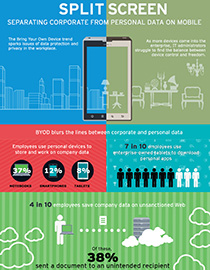Employees and Employers Share the BYOD Burden
February 24, 2014
 View infographic: Separating Corporate from Personal Data on Mobile Devices
View infographic: Separating Corporate from Personal Data on Mobile Devices
Gartner predicts that 50% of employers will embrace BYOD by 2017. These employers believe that BYOD enhances employee productivity. What they may not be fully aware of are the risks that come with this measure. About 2 in 5 large data breaches are caused by lost or stolen employee devices, and roughly 3 in 10 employees with company data stored on unsanctioned Web services are responsible for security breaches.
To maximize the benefits of BYOD without increasing the risks, companies and their employees need to strike a balance between maintaining employee privacy and having control over corporate data on devices. Employers, for example, can set clear guidelines or BYOD policies that employees need to follow to avoid corporate data from spilling out. Employees, on the other hand, need to abide by these rules but make sure that their own data is safe from prying eyes.
More is discussed in Split Screen, an interactive infographic detailing the steps companies can take to protect their data and that of their employees.
HIDE

Like it? Add this infographic to your site:
1. Click on the box below. 2. Press Ctrl+A to select all. 3. Press Ctrl+C to copy. 4. Paste the code into your page (Ctrl+V).
Image will appear the same size as you see above.
Recent Posts
- Estimating Future Risk Outbreaks at Scale in Real-World Deployments
- The Next Phase of Cybercrime: Agentic AI and the Shift to Autonomous Criminal Operations
- Reimagining Fraud Operations: The Rise of AI-Powered Scam Assembly Lines
- The Devil Reviews Xanthorox: A Criminal-Focused Analysis of the Latest Malicious LLM Offering
- AI Security Starts Here: The Essentials for Every Organization

 Complexity and Visibility Gaps in Power Automate
Complexity and Visibility Gaps in Power Automate AI Security Starts Here: The Essentials for Every Organization
AI Security Starts Here: The Essentials for Every Organization The AI-fication of Cyberthreats: Trend Micro Security Predictions for 2026
The AI-fication of Cyberthreats: Trend Micro Security Predictions for 2026 Stay Ahead of AI Threats: Secure LLM Applications With Trend Vision One
Stay Ahead of AI Threats: Secure LLM Applications With Trend Vision One